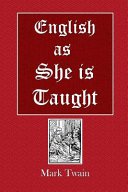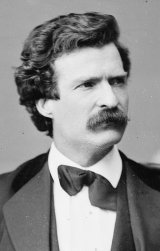English as She is Taught Page #2
As the greatest compliment that could be paid a writer would be the assumption that the material contained in this little volume was the product of that writer's ingenuity or imagination, it seems needless for the compiler to state that every line is just what it purports to be, - bona fide answers to questions asked in the public schools. Mark Twain, with his inimitable drollery, comments in the "Century Magazine" for April, 1887, upon "English As She is Taught." Even this master of English humor acknowledges his inability to comprehend how such
He preached to an egregious congregation. The captain eliminated a bullet through the man’s heart. You should take caution and be precarious. The supercilious girl acted with vicissitude when the perennial time came. That last is a curiously plausible sentence; one seems to know what it means, and yet he knows all the time that he doesn’t. Here is an odd (but entirely proper) use of a word, and a most sudden descent from a lofty philosophical altitude to a very practical and homely illustration: He should endeavour to avoid extremes—like those of wasps and bees. And here—with “zo� logical” and “geological” in his mind, but not ready to his tongue—the small scholar has innocently gone and let out a couple of secrets which ought never to have been divulged in any circumstances: There are a good many donkeys in theological gardens. Some of the best fossils are found in theological cabinets. Under the head of “Grammar” the little scholars furnish the following information: Gender is the distinguishing nouns without regard to sex. A verb is something to eat. Adverbs should always be used as adjectives and adjectives as adverbs. Every sentence and name of God must begin with a caterpillar. “Caterpillar” is well enough, but capital letter would have been stricter. The following is a brave attempt at a solution, but it failed to liquify: When they are going to say some prose or poetry before they say the poetry or prose they must put a semicolon just after the introduction of the prose or poetry. The chapter on “Mathematics” is full of fruit. From it I take a few samples—mainly in an unripe state. A straight line is any distance between two places. Parallel lines are lines that can never meet until they run together. A circle is a round straight line with a hole in the middle. Things which are equal to each other are equal to anything else. To find the number of square feet in a room you multiply the room by the number of the feet. The product is the result. Right you are. In the matter of geography this little book is unspeakably rich. The questions do not appear to have applied the microscope to the subject, as did those quoted by Professor Ravenstein; still they proved plenty difficult enough without that. These pupils did not hunt with a microscope, they hunted with a shotgun; this is shown by the crippled condition of the game they brought in: America is divided into the Passiffic slope and the Mississippi valey. North America is separated by Spain. America consists from north to south about five hundred miles. The United States is quite a small country compared with some other countrys, but is about as industrious. The capital of the United States is Long Island. The five seaports of the U. S. are Newfunlan and Sanfrancisco. The principal products of the U. S. is earthquakes and volcanoes. The Alaginnies are mountains in Philadelphia. The Rocky Mountains are on the western side of Philadelphia. Cape Hateras is a vast body, of water surrounded by land and flowing into the Gulf of Mexico. Mason and Dixon’s line is the Equater. One of the leading industries of the United States is mollasses, book-covers, numbers, gas, teaching, lumber, manufacturers, paper-making, publishers, coal. In Austria the principal occupation is gathering Austrich feathers. Gibraltar is an island built on a rock. Russia is very cold and tyrannical. Sicily is one of the Sandwich Islands. Hindoostan flows through the Ganges and empties into the Mediterranean Sea. Ireland is called the Emigrant Isle because it is so beautiful and green. The width of the different zones Europe lies in depend upon the surrounding country. The imports of a country are the things that are paid for, the exports are the things that are not. Climate lasts all the time and weather only a few days. The two most famous volcanoes of Europe are Sodom and Gomorrah. The chapter headed “Analysis” shows us that the pupils in our public schools are not merely loaded up with those showy facts about geography, mathematics, and so on, and left in that incomplete state; no, there’s machinery for clarifying and expanding their minds. They are required to take poems and analyze them, dig out their common sense, reduce them to statistics, and reproduce them in a luminous prose translation which shall tell you at a glance what the poet was trying to get at. One sample will do. Here is a stanza from “The Lady of the Lake,” followed by the pupil’s impressive explanation of it. Alone, but with unbated zeal, The horseman plied with scourge and steel; For jaded now and spent with toil, Embossed with foam and dark with soil, While every gasp with sobs he drew, The laboring stag strained full in view. The man who rode on the horse performed the whip and an instrument made of steel alone with strong ardor not diminishing, for, being tired from the time passed with hard labor overworked with anger and ignorant with weariness, while every breath for labor he drew with cries full of sorrow, the young deer made imperfect who worked hard filtered in sight. I see, now, that I never understood that poem before. I have had glimpses of its meaning, in moments when I was not as ignorant with weariness as usual, but this is the first time the whole spacious idea of it ever filtered in sight. If I were a public-school pupil I would put those other studies aside and stick to analysis; for, after all, it is the thing to spread your mind. We come now to historical matters, historical remains, one might say. As one turns the pages, he is impressed with the depth to which one date has been driven into the American child’s head—1492. The date is there, and it is there to stay. And it is always at hand, always deliverable at a moment’s notice. But the Fact that belongs with it? That is quite another matter. Only the date itself is familiar and sure: its vast Fact has failed of lodgment. It would appear that whenever you ask a public-school pupil when a thing—anything, no matter what—happened, and he is in doubt, he always rips out his 1492. He applies it to everything, from the landing of the ark to the introduction of the horse-car. Well, after all, it is our first date, and so it is right enough to honor it, and pay the public schools to teach our children to honor it: George Washington was born in 1492. Washington wrote the Declaration of Independence in 1492. St. Bartholemew was massacred in 1492. The Brittains were the Saxons who entered England in 1492 under Julius Cæsar. The earth is 1492 miles in circumference. To proceed with “History”: Christopher Columbus was called the father of his Country. Queen Isabella of Spain sold her watch and chain and other millinery
Translation
Translate and read this book in other languages:
Select another language:
- - Select -
- 简体中文 (Chinese - Simplified)
- 繁體中文 (Chinese - Traditional)
- Español (Spanish)
- Esperanto (Esperanto)
- 日本語 (Japanese)
- Português (Portuguese)
- Deutsch (German)
- العربية (Arabic)
- Français (French)
- Русский (Russian)
- ಕನ್ನಡ (Kannada)
- 한국어 (Korean)
- עברית (Hebrew)
- Gaeilge (Irish)
- Українська (Ukrainian)
- اردو (Urdu)
- Magyar (Hungarian)
- मानक हिन्दी (Hindi)
- Indonesia (Indonesian)
- Italiano (Italian)
- தமிழ் (Tamil)
- Türkçe (Turkish)
- తెలుగు (Telugu)
- ภาษาไทย (Thai)
- Tiếng Việt (Vietnamese)
- Čeština (Czech)
- Polski (Polish)
- Bahasa Indonesia (Indonesian)
- Românește (Romanian)
- Nederlands (Dutch)
- Ελληνικά (Greek)
- Latinum (Latin)
- Svenska (Swedish)
- Dansk (Danish)
- Suomi (Finnish)
- فارسی (Persian)
- ייִדיש (Yiddish)
- հայերեն (Armenian)
- Norsk (Norwegian)
- English (English)
Citation
Use the citation below to add this book to your bibliography:
Style:MLAChicagoAPA
"English as She is Taught Books." Literature.com. STANDS4 LLC, 2025. Web. 22 Feb. 2025. <https://www.literature.com/book/english_as_she_is_taught_262>.








Discuss this English as She is Taught book with the community:
Report Comment
We're doing our best to make sure our content is useful, accurate and safe.
If by any chance you spot an inappropriate comment while navigating through our website please use this form to let us know, and we'll take care of it shortly.
Attachment
You need to be logged in to favorite.
Log In